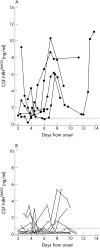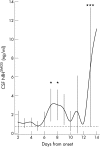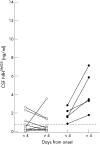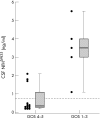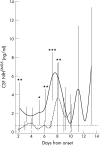Axonal damage and outcome in subarachnoid haemorrhage
- PMID: 16705199
- PMCID: PMC2077447
- DOI: 10.1136/jnnp.2005.085175
Axonal damage and outcome in subarachnoid haemorrhage
Abstract
Background: On the basis of preliminary evidence from patients with subarachnoid haemorrhage (SAH), axonal degeneration is thought to be an underestimated pathological feature.
Methods: A longitudinal study in 17 patients with aneurysmal SAH. Ventricular CSF was collected daily for up to 14 days. The neurofilament heavy chain(SMI35) (NfH(SMI35), a biomarker for axonal damage) was quantified using a standard ELISA (upper limit of normal 0.73 ng/ml). The primary outcome measure was the Glasgow Outcome Score (GOS) at 3 months.
Results: Of 148 samples from patients with SAH, pathologically high NfH levels in the CSF were found in 78 (52.7%) samples, compared with 20 (5%) of 416 samples from the reference population (p<0.0001). A pathological increase in NfH was observed in all patients with a bad outcome (GOS 1-3) compared with 8% of those with a good outcome (GOS 4-5, p<0.0001). This increase typically became significant 7 days after the haemorrhage (p<0.01). The result was confirmed by analysing the individual mean NfH concentrations in the CSF (3.45 v 0.37 ng/ml, p<0.01), and was reinforced by the inverse correlation of NfH in the CSF with the GOS (r = -0.65, p<0.01). Severity of injury was found to be correlated to NfH(SMI35) levels in the CSF (World Federation of Neurological Surgeons, r = 0.63, p<0.01 and Glasgow Coma Score, r = -0.61, p<0.01).
Conclusion: Patients with SAH thus have secondary axonal degeneration, which may adversely affect their outcome.
Conflict of interest statement
Competing interests: None declared.
Comment in
-
Unravelling the causes of cerebral damage in subarachnoid haemorrhage: might biomarkers help?J Neurol Neurosurg Psychiatry. 2006 Jun;77(6):711. doi: 10.1136/jnnp.2006.089581. J Neurol Neurosurg Psychiatry. 2006. PMID: 16705191 Free PMC article.
Similar articles
-
Axonal pathology in subarachnoid and intracerebral hemorrhage.J Neurotrauma. 2005 Mar;22(3):407-14. doi: 10.1089/neu.2005.22.407. J Neurotrauma. 2005. PMID: 15785235
-
Axonal damage accumulates in the progressive phase of multiple sclerosis: three year follow up study.J Neurol Neurosurg Psychiatry. 2005 Feb;76(2):206-11. doi: 10.1136/jnnp.2004.043315. J Neurol Neurosurg Psychiatry. 2005. PMID: 15654034 Free PMC article.
-
Neurofilament heavy chain as a marker of neuroaxonal pathology and prognosis in acute encephalitis.Eur J Neurol. 2014 Jun;21(6):845-50. doi: 10.1111/ene.12390. Epub 2014 Mar 29. Eur J Neurol. 2014. PMID: 24684186
-
[Idiopathic subarachnoid hemorrhage; comparison of different bleeding patterns and long-term outcome].Neurocirugia (Astur). 2002 Apr;13(2):110-9. doi: 10.1016/s1130-1473(02)70630-1. Neurocirugia (Astur). 2002. PMID: 12058602 Review. Spanish.
-
Effect of statin treatment on vasospasm-related morbidity and functional outcome in patients with aneurysmal subarachnoid hemorrhage: a systematic review and meta-analysis.J Neurosurg. 2017 Aug;127(2):291-301. doi: 10.3171/2016.5.JNS152900. Epub 2016 Oct 7. J Neurosurg. 2017. PMID: 27715439
Cited by
-
Corticothalamic Connectivity in Aneurysmal Subarachnoid Hemorrhage: Relationship with Disordered Consciousness and Clinical Outcomes.Neurocrit Care. 2022 Jun;36(3):760-771. doi: 10.1007/s12028-021-01354-6. Epub 2021 Oct 20. Neurocrit Care. 2022. PMID: 34669180
-
Ubiquitin C-terminal hydrolase-L1 as a biomarker for ischemic and traumatic brain injury in rats.Eur J Neurosci. 2010 Feb;31(4):722-32. doi: 10.1111/j.1460-9568.2010.07097.x. Eur J Neurosci. 2010. PMID: 20384815 Free PMC article.
-
A motor neuron strategy to save time and energy in neurodegeneration: adaptive protein stoichiometry.J Neurochem. 2018 Sep;146(5):631-641. doi: 10.1111/jnc.14542. J Neurochem. 2018. PMID: 29959860 Free PMC article.
-
Neurofilament light chain levels in ventricular cerebrospinal fluid after acute aneurysmal subarachnoid haemorrhage.J Neurol Neurosurg Psychiatry. 2011 Feb;82(2):157-9. doi: 10.1136/jnnp.2009.177667. Epub 2010 Jun 22. J Neurol Neurosurg Psychiatry. 2011. PMID: 20571038 Free PMC article.
-
The 2022 Lady Estelle Wolfson lectureship on neurofilaments.J Neurochem. 2022 Nov;163(3):179-219. doi: 10.1111/jnc.15682. Epub 2022 Sep 19. J Neurochem. 2022. PMID: 35950263 Free PMC article. Review.
References
MeSH terms
Substances
LinkOut - more resources
Full Text Sources
Medical
Research Materials

